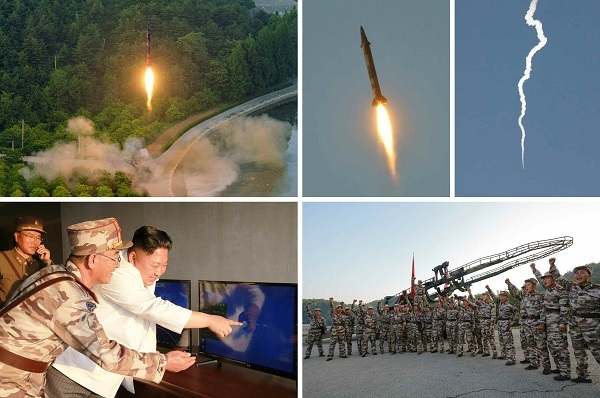N. Korea seeks 'carrier-killer' missile amid technical hurdle
By a2017001Published : May 30, 2017 - 15:51
North Korea asserted Tuesday that it has developed a means to strike moving targets at sea with precision.
The North said it used a new precision-guidance system in the latest ballistic missile test.
The rocket, fired from the country's east coast early Monday morning, traveled around 450 kilometers to splash into the East Sea, according to the South Korean military.

The North said it has halved the range for the test. It means the missile's actual range is similar to a Scud-ER (extended range) at about 1,000 km, a potential threat to American troops stationed in Japan and to be deployed expeditiously to Korea in case of an emergency.
The missile launched Monday is apparently a Scud-ER variant with auxiliary equipment for flight stability and accuracy.
Observing the launch from the east coast, the North's leader Kim Jong-un likened the missile to a "sniper's rifle" for its ability to strike targets both on the ground and at sea, including enemy warships.
The North's pursuit of its own anti-ship ballistic missile, often called an "aircraft carrier killer," is an open secret, with two US aircraft carriers -- USS Carl Vinson and USS Ronald Reagan -- currently operating in the Western Pacific as a show of force.
The Kim regime is apparently emboldened by the development of the Pukguksong-2 intermediate-range ballistic missile that can travel up to 5,000 km.
It's now focusing on mastering the technology for intercontinental ballistic missiles, enhancing the precision of the ballistic missiles already in its stockpile -- either liquid-or solid-fueled -- and cutting down launch preparation time.
Noteworthy is the claim that Monday's missile hit a planned target point with a deviation of only seven meters.
If true, its accuracy is quite impressive. The circular error probable, a measure of missile accuracy, of the North's Nodong mid-range missiles is known to be 2-3 km when it is flown 1,000 km. That of Scud missiles is 450 m to 1 km after flying 300 km. China's DF-21D ASBM reportedly has a CEP of 30-40 meters.
North Korea watchers point out the secretive communist state's claim of a seven-meter variation is hard to verify.
Given the appearance of the new missile unveiled at the April 15 military parade in Pyongyang, however, the North's assertion related to its flight stability may be true.
Its warhead was seen with the addition of what appear to be control wings for use during the boost stage.
The North also said it used a "small heat jet engine" in the middle-flying section to improve speed control and stabilization and an "ultra-precision guidance correctness" in the terminal stage.
The North is believed to have moved forward in efforts to raise some maneuverability for ground targets.
The question is whether it has acquired the ability for precise and high-performance terminal guidance based on in-flight updates or advanced sensors to hit floating targets at sea.
It seems to be lacking the over-the-horizon radar capabilities and other long-range surveillance and reconnaissance assets, which are among key requirements for ASBM.
The ASBM warhead needs not only GPS receivers but also a cutting-edge homing device.
In Tuesday's lengthy statement on its "successful" rocket test, there was no mention of such a system.
"As North Korea has no satellite and surveillance assets, there's limit in operating ASBM," said Chang Yong-keun, a professor at Korean Aerospace University. "Instead, it has been actively developing a sensor to raise the accuracy of its missiles since the early 2000s." (Yonhap)









![[Weekender] Korean psyche untangled: Musok](http://res.heraldm.com/phpwas/restmb_idxmake.php?idx=644&simg=/content/image/2024/05/02/20240502050841_0.jpg&u=)







![[Eye Interview] 'If you live to 100, you might as well be happy,' says 88-year-old bestselling essayist](http://res.heraldm.com/phpwas/restmb_idxmake.php?idx=652&simg=/content/image/2024/05/03/20240503050674_0.jpg&u=)
